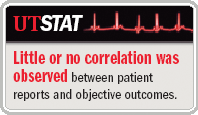Article
Expectations guide patients' view of incontinence treatment
Urinary incontinence patients' personal goals and expectations are more closely tied to their quality of life than is any objective measure of the disease, suggesting that treatment outcomes should be assessed in a more patient-focused manner.

Key Points
Christchurch, New Zealand-Urinary incontinence patients' personal goals and expectations are more closely tied to their quality of life than is any objective measure of the disease, suggesting that treatment outcomes should be assessed in a more patient-focused manner.

"We have a tendency to decide whether to [perform surgery] on these patients based on some number or result of an expensive urodynamic study," said Kimberly Kenton, MD, assistant professor of urogynecology, department of urology, Loyola University Medical Center, Maywood, IL. "But the results of these tests may not be optimal indicators of disease severity or predict satisfaction after surgery. It may be that when we treat quality-of-life disorders, such as incontinence or vaginal prolapse, we should use patient assessment of disease severity to measure outcomes."
"No clear definition of 'cured' or 'happy' was provided, making it impossible to interpret," Dr. Kenton told attendees at the International Continence Society annual meeting here. "Furthermore, it was complicated by the bias that patients in general like their surgeons and might not want to admit that things did not work.
"As a result, the pendulum swung in the other direction to these arbitrary, but quantifiable and reproducible 'objective' outcomes. Increasingly, data show the lack of a relationship between objective outcomes and quality of life, so we are ever in search of the 'right' outcome measure."
The study undertaken by Dr. Kenton and colleagues was conducted at 23 centers across North America. Data were available for 329 women (mean age, 56±12 years) with urodynamic stress incontinence who received either a dextranomer in a hyaluronic acid base (Zuidex) or bovine collagen (Contigen).
Forty percent of the women reported having incontinence symptoms for 1 to 5 years, while the remaining 60% had symptoms for more than 5 years. Objective measures taken for each patient included urodynamics with abdominal leak point pressures (median pressure, 68 cm water), standard office pad test (median weight, 51 grams), and incontinence episodes per day (median number, 4).
Subjective data were obtained using the short forms of the Urinary Distress Inventory and the Incontinence Impact Questionnaire. Patients were also asked about the severity of their incontinence using the Patient's Global Assessment of Incontinence (PGAI), in which they rated their disease as "none," "mild," "moderate," or "severe." Most of the women (52%) described their incontinence as moderate, 25% said it was mild, 21% rated it as severe, and 3% responded "none."
Similarly, patients were asked their perceived incontinence grade. Fifty-one percent reported "leaking with lesser degrees of physical stress," 45% reported "loss of urine with sudden increase in abdominal pressure," and 4% reported "total incontinence."
Univariate analysis showed no correlation between questionnaire scores and leak point pressures, and only a weak correlation between those scores and the number of incontinence episodes per day and pad weight.
Higher questionnaire scores were significantly associated with worse patient assessments of incontinence using the grading system and the PGAI.
"These results are consistent with a body of work we are accumulating about patients' goals and expectations for surgery," said Dr. Kenton, whose group planned to present data at the Society of Gynecologic Surgeons annual meeting in April, showing that women who do not feel completely prepared before incontinence surgery are more likely to be dissatisfied afterward, regardless of outcomes.
Newsletter
Stay current with the latest urology news and practice-changing insights — sign up now for the essential updates every urologist needs.
















